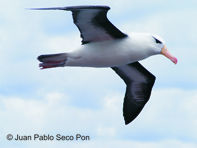Sofía Copello (Grupo Vertebrados, Instituto de Investigaciones Marinas y Costeras CONICET – UNMdP, Argentina) and colleagues have looked at the spatial overlap between albatrosses, chiefly the Black-browed Albatross Thalassarche melanophris, and the commercial fishing fleet operating off Argentina. Their findings have been published recently in the online version of Journal of Sea Research.
The paper’s English abstract follows:
“Incidental mortality in fisheries is the main at-sea threat albatrosses are facing nowadays. In this study we used remote sensing techniques to model the degree of spatial overlapping between the Black-browed albatross (Thalassarche melanophris) and Argentine fisheries, assuming this as a proxy of risk for albatrosses. Eleven tags were deployed on albatrosses during the non-breeding seasons 2011 and 2012 in the Patagonian Shelf. Their distribution overlapped to different extent with the two coastal trawl, three offshore trawl and one demersal longline fisheries. The overlap index showed highest values with both coastal fleets, followed by the ice-chilling trawl fleet. These intersections were located in the Argentine-Uruguay Common Fishing Zone, in coastal areas of the SE of Buenos Aires province, El Rincón estuary and over the shelf break. The analysis of intersections of focal areas from albatrosses and all fisheries allowed us the identification of thirty-four fishing management units (1° by 1° grid within the Argentine EEZ) classified as of medium, high or very high conservation priority. Very high priority units were placed between 35 and 38°S in the external mouth of Rio de la Plata, and between 45 and 47°S in neighboring waters East to the hake fishing closure. Although possible biases due to the limited number of tracked birds and the locations where albatrosses were captured and instrumented, the information presented in this study provides a comprehensive picture of important areas of overlapping during winter that could be used by the fishery administration to prioritize conservation actions under limited resource scenarios”.

Black-browed Albatross, photograph by Juan Pablo Seco Pon
Reference:
Copello, S., Seco Pon, J.P. & Favero, M. 2014. Spatial overlap of Black-browed albatrosses with longline and trawl fisheries in the Patagonian Shelf during the non-breeding season. Journal of Sea Research. doi: 10.1016/j.seares.2014.02.006.
Juan Pablo Seco Pon, ACAP South American News Correspondent, 20 March 2014

 English
English  Français
Français  Español
Español